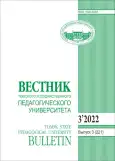Abstract
Introduction. The genre of idyll, which has been developing in world literature since Antiquity, is crucial for the poetics of Russian literature in the first third of the XIX century. The aesthetics of Romanticism helped it develop, and thus a romantic idyll arose. A great contribution to the development of idyll in Russia was made by V. A. Zhukovsky, the founder of Romanticism in Russian literature. The scale of the poet’s work was quite large and influenced the works of his contemporaries, among whom was N. V. Gogol, who showed considerable interest in idyllic themes in his youth. Aim and objectives. In this regard, the purpose of the article is to determine the features of V. A. Zhukovsky’s idyllic model implementation in N. V. Gogol’s early poem “Ganz Kuchelgarten”. Material and methods. The material of the study is the idyllic poem by N. V. Gogol “Ganz Kuchelgarten”, as well as the works of V. A. Zhukovsky that influenced it, including an idyll “The Village Watchman at Midnight”, “pavlovian poems”, the poems “Theon and Aeschines”, “Anguish” (“toska”), “Lalla-Rookh”, “There the heavens and waters are clear!”, the elegies “Slavyanka” and “Evening”, the romance “Desire”, the song “Traveller”, the article “About a simple and decorated style”. Biographical and comparative research methods are used in the work. Results and discussion. The genre of idyll is very close to V. A. Zhukovsky. An idyllic worldview exists organically in his poetic consciousness. The period of the poet’s strong interest in idyll is synchronized with his youth. In his youth, he draws new poetic forms mainly from European idylls. In them Zhukovsky is attracted by images of simple, everyday life, focus on rural nature, patriarchal mores. The poet is especially inspired by the natural philosophical aspects. The distinctive features of Zhukovsky’s works created in this genre are descriptiveness, an abundance of static natural paintings, free verse. In addition, we will separately highlight the author’s aim at reproducing the natural dynamics of life. The poet acts as a painter who strives to convey in his paintings the smallest details of the inner nature life. However, this is only an explicit part of Zhukovsky’s idylls. Their implicit part is much more important. By it we mean the sacred, the religious and the mystical. We see a certain evolution of Zhukovsky’s idyll. From the glorification of landscapes and the depiction of human life in the bosom of nature, the poet consciously moves to a more complex creative stage, focusing on the mystical and listening to his religious feeling. As for other features of the idyll genre in Zhukovsky’s work, like contrast or two-worldness of romanticism, the works of this genre translated by him are an alloy, a synthesis of the beautiful and the enigmatic in the world. It is no coincidence that many of them open with night landscapes. These were the features of the idyll genre implementation in Zhukovsky’s creative system. It was under their influence that N. V. Gogol wrote his first work, the poem “Ganz Kuchelgarten”. Zhukovsky’s idyllic model in Gogol’s poem “Ganz Kuchelgarten” is identified almost immediately. This is confirmed, firstly, by the topos of the poem (rural hinterland). Secondly, by the fact that the reader is shown pictures of pastoral life. It is also important that at the beginning of the poem there is an image of the family (patriarchy is an important aspect of the idyll). In addition, Gogol’s poem reveals other traditional topos for idyll (house, garden). Following the example of Zhukovsky, Gogol uses the motifs of food, sleep and music in the work. They are widely represented in the text and emphasize the idyllic moments of the poem. The heroic series can also be considered traditional for the idyll (the canons of which in Russian literature were first laid by Zhukovsky), since the author’s detailed representation of Louise’s family is following an idyllic orientation to the fullness of life, which here is the integrity of the family. The poem shows the desire of the characters to achieve happiness, they dream of an idyllic life. However, romantic features are more visible in the main character of the poem. And yet it lacks the passion of Byron’s heroes. At the end, Ganz rather follows the line of behavior of Aeschines, embodied by Zhukovsky. Conclusion. Thus, Gogol, when working on his youthful poem “Ganz Kuchelgarten”, was guided by the idyllic model of Zhukovsky. This is indicated by the traditional elements of the poet’s idylls, which are clearly present in Gogol’s text (the image of a family, pastoral landscapes, natural cycles, the motif of food, sleep and childhood). However, Gogol ignores some important elements inherent in Zhukovsky’s idylls. So, Gogol’s main character demonstrates the features of a romantic hero rather than an idyllic one. In addition, there is no pronounced mystical veil in Gogol’s poem. And finally, dissonance (the substratum of the romantic and idyllic) is certainly felt in it. The reason for it lies in the insufficiently thought-out compilation of leading European and Russian writers’ artistic techniques.






